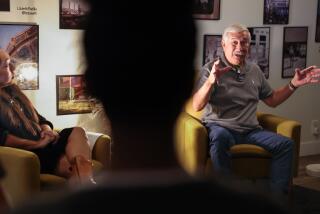Black Pilots Gather for Air Show, Urge Youths to Aim High
Pilots never forget the first time, being up in the sky, feeling bird-like and free. It ranks right up there with prom night, a first kiss, graduation.
“The first time I went up by myself I flew around the airport with a big smile on my face, thinking, ‘Yes, I did it,’ ” pilot Gregory L. Wright said. “I grew up watching airplanes, always wishing and dreaming. It was a milestone.”
Now Wright owns one plane and is building another, and as often as he can he tries to reach a youth who might also be watching and dreaming. “I’m always looking to take kids up, “ he said.
In that spirit of sharing smiles and teaching skills, the California Black Aviation Assn. held its fourth annual Compton Air Fair on Saturday, attracting hundreds to the Compton Municipal Airport for an up-close look at the world of flight.
*
The event was created to allow children to “see some things they normally may not see and to expose the African American community to aviation,” said association President Dr. Douglas Hardy. “African Americans have already made many contributions to aviation, and we want to keep that going.”
The daylong event included parachutists, displays of airplanes and helicopters, remote-controlled model planes, information booths and a visit from an astronaut.
Children lined up for a chance to sit in the cockpit of a World War II vintage P-51 Mustang, a purple plane that bears a picture of Snoopy as the “Red Baron” painted on the tail wing.
Chris Savoy, a certified flight instructor, knelt on the wing of the plane, answering questions of wide-eyed youths staring at buttons, dials and gears.
“How does it fly?” asked Mychal Riley, an 8-year-old.
Savoy thought for a moment, then offered the short answer.
*
“The propeller turns, forcing air backward, and that action causes the plane to go forward,” Savoy said. “And as the airplane moves forward, air flows along the wings. That creates high and low pressure and that creates lift.”
“If the air is moving backward, I think the plane should move back,” Mychal countered. And so Savoy explained again. This was a day for teaching.
But it was also a time of reflection, a day to remember those who found a way to soar even when the odds seemed insurmountable, when even the skies above seemed to carry a “whites only” sign.
Bessie Coleman, the first licensed black pilot in the nation, earned her international pilot’s license in 1921. No U.S. school would teach Coleman, so she went to France. When she returned, she traveled around the country, barnstorming and teaching African Americans about aviation.
“I was thinking about her when [the parachutists] jumped out the plane,” said Famous Limbrick Jr., who flew from Oakland to attend the event. “She’s smiling on us.”
Limbrick grew up in Jasper, Texas, during a time when a black person “couldn’t hang out at the airport.”
“Only white folks,” he said. “A lot of things weren’t open to us, but still I had that desire. I wanted to fly all my life.”
Not until seven years ago did Limbrick, 50, learn to fly.
“It’s the ultimate,” he said. “Who knows how many kids out here might have that spark, that desire to fly?”
Events like the air show can fuel the spark and introduce youths to careers available in the field, he said.
Hardy, 31, learned about aviation from the place where black men proudly laid to rest assumptions about their inability to fly.
“I went to school at Tuskegee and I was always hearing about [the Tuskegee Airmen],” said Hardy, a graduate of Tuskegee University in Alabama. “Col. Lewis, the ROTC instructor, took me on my first flight.”
Hardy also had an opportunity to meet the legendary Chief Charles Alfred Anderson, who trained the Tuskegee Airmen, the first black fighter pilots to serve in the U.S. military. Until 1939 the Army Air Corps refused to accept African Americans. An act of Congress changed that. In all-black Army Corps units the men fought valiantly abroad, and changed U.S. military policies and racial restrictions at home.
*
Tuskegee Airman Charles Foreman, 76, of Inglewood placed the work of the black aviation association squarely in his group’s long tradition of education.
“There is nothing that I love more than teaching and sharing and motivating young people,” he said. “I will serve as long as life lasts.”
Astronaut Stephanie Wilson took the aviation tradition one step further, speaking to an enthusiastic crowd about travel in space.
“We come from a rich heritage,” said Wilson, who flew in for the event. “Don’t let anybody tell you there’s anything you can’t do.”
Young people like Christine White, 12, of Fontana are already convinced.
“I love to learn about [aviation],” said Christine, who flies often with her father and brother. “If I’m going somewhere and a plane is going down, I’ll know what to do.”
More to Read
Sign up for The Wild
We’ll help you find the best places to hike, bike and run, as well as the perfect silent spots for meditation and yoga.
You may occasionally receive promotional content from the Los Angeles Times.






